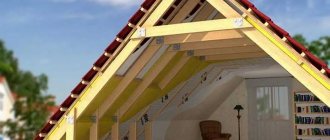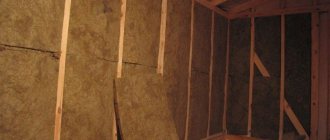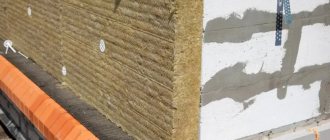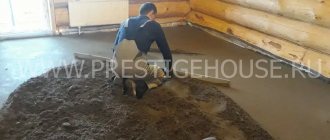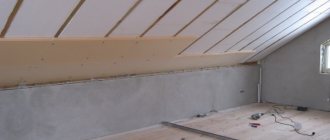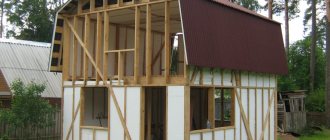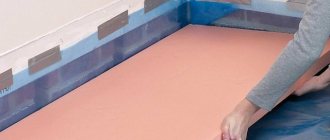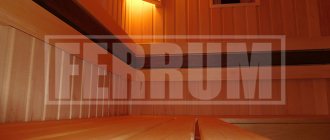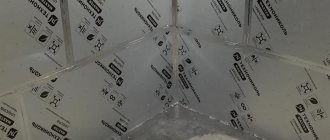There are several ways to figure out how suitable foam materials are for an attic space. For example, use reviews about attic insulation with polystyrene foam. It’s even better if you manage to take part at least once in the process of laying insulation in a residential attic or any other room similar in structure and size to an attic. Once done with your own hands, insulating an attic with penoplex is worth ten reviews, although, from a practical point of view, you can find a lot of rational ideas in them.
Is it possible to insulate an attic from the inside with penoplex?
The problem of using foamed polystyrene or its more rigid and durable form - extruded penoplex has always been associated with the safety of the material. The main obstacle preventing insulation with expanded polystyrene from the inside of the attic, according to reviews from developers, is considered to be:
- The presence in the foamed structure of polystyrene foam of residues of the primary solvent styrene and foam-forming freons, inhalation of which can lead to serious illnesses;
- Flammability of the material. Unlike mineral wool or even polyurethane foam, attic insulation made from polystyrene foam burns very quickly, releasing a huge amount of toxic thermal decomposition products.
It cannot be said that fears regarding the use of polystyrene foam insulation are too exaggerated. According to reviews, few developers really understand the dangers of old polystyrene foam, and that both factors are more relevant to foam plastics and EPS produced using old technology.
Important! The vast majority of modern polystyrene foam manufacturers have long abandoned freon; the residual toluene content in the mass is controlled by technology, and special additives of non-ferrous metal salts are used to reduce flammability.
Moreover, polystyrene foam, intended for insulating the walls of attics, verandas, and rooms of residential buildings, has appropriate markings that are different from technical foam plastic and EPS for communications and road construction. It is with this type of penoplex that you can insulate an attic, without any particular risk to the health of the residents.
Characteristics
There is also no clarity about the characteristics of the material.
Thermal conductivity
When advertising their products, sellers indicate very low thermal conductivity values of polyurethane foam. Rarely, you can find a coefficient of 0.017 W/(m×°K), more often - 0.020-0.022 W/(m×°K). But this is from the realm of fantasy. Even in laboratory conditions, where all requirements for the quality of components and their formulation can be met, it is rarely possible to obtain a thermal conductivity index of 0.022 W/(m×°K).
Similar values are achieved only with the use of freon r141b as a foaming agent, which is prohibited for use in Europe (and therefore is not produced). The use of other foaming agents increases the value of the coefficient, and therefore in European countries a thermal insulation layer with a thermal conductivity of 0.028 W/(m×°K) is considered high quality.
In Russia, the real figures are 0.030-0.035 W/(m×°K) (the specific value depends on the experience of the performers).
However, consumers should not be upset. Even if the technology is violated, the actual thermal conductivity of the insulation deserves respect, since it is one of the best and comparable to basalt wool.
Density
The density of the insulation determines the bending strength (fragility), the weight load on the structure and the thermal insulation properties.
Two-component, closed-cell polyurethane foam, can be obtained in different densities, combined into 3 groups.
- 1 group. Low density - 28-32 kg/m3. The main scope of application is ceilings and walls from inside the room, onto which the material is applied in a thin layer. Thermal conductivity coefficient is from 0.028 to 0.032 W/(m×°K). Vapor permeability at the wood level is 0.05 mg/(m*h*Pa), which makes it possible, albeit conditionally, after detailed calculations, to use polyurethane foam for insulating the walls of wooden houses (more on the problem below).
- 2nd group. Average density - 32-40 kg/m3. A classic representative of the species. The components are sold separately, in cylinders. Used to insulate all structural elements of a building. It has the lowest percentage of moisture absorption among all types of insulation.
- 3rd group. High density - 40-80 kg/m3. Achieving such density using portable equipment is theoretically possible, but practically impossible. It is used in places with high mechanical load on the heat-insulating layer, but only after special surface treatment, which experts call armoring.
Life time
Manufacturers of polyurethane foam consider their products to be durable, with a service life of 30-50 years. These figures are confirmed by the experience of using this insulation in the USA and Europe. However, in Russia, in the first years of using the new product, they were faced with the fact that the insulation from the facades of multi-storey buildings began to fall off in layers after 5-6 years of operation.
At first, the root of the evil was seen in the poor adhesion of polyurethane foam to the wall material. When the lag became widespread, they began to study the problem seriously and turned to Western experience. It turned out that the reason is in a completely different plane - the sun's rays. The material does not tolerate ultraviolet irradiation, ages, or in the language of scientists: it is subject to UV destruction. The aging rate is about 1 mm per year.
The worst enemy of polyurethane foam is the sun.
Simply painting the insulating layer with fade-resistant paint or mastic protects the material from destruction, extending its service life to 30 years when the facade is open. If the insulated facade is finished with siding or porcelain stoneware, you don’t have to worry about the safety of the insulation at all.
Adhesion
Foamed polyurethane has excellent adhesion to all types of building materials, with the exception of polyethylene film. For example, in order to tear polymerized insulation from concrete, you will have to apply a force of at least 2.5 kg/cm2, and for steel - 1.5 kg/m2. These are very large numbers. No wonder the best types of glue are polyurethane based. But such adhesion is possible only if the insulation is sprayed onto a clean and dry surface.
The insulation will not adhere to whitewash and “boiling” plaster; it will fall off along with them under minor mechanical loads due to low bending strength.
Pros and cons of attic insulation with polystyrene foam
It cannot be said that penoplex has completely and completely replaced all competing methods of insulation. According to reviews, along with EPS, craftsmen actively use mineral wool and fiberglass materials, polyurethane foam and granule-based backfills to insulate attics and residential buildings.
Insulating the attic with extruded polystyrene foam makes sense in two cases:
- The house with an attic was built in an area with a fairly humid climate; polystyrene foam insulation, unlike expanded clay and mineral wool, is not afraid of fog and “wet” air, so it can be used even without external cladding;
- A country house or country house with an attic is visited in winter no more than 1-2 times a week. The use of insulation based on polystyrene foam guarantees the safety of thermal insulation under conditions of fluctuating temperatures and humidity.
It is clear that penoplex and lighter foam plastic have disadvantages, which in some cases can outweigh even the positive qualities of the material. In addition to the fact that polystyrene foam insulation can burn in direct contact with the fire front, the material is also quite sensitive to solar ultraviolet radiation. Therefore, when insulating the gables of a dacha with an attic, the heat-insulating layer must be laid only from the inside of the room, or use siding. According to reviews, penoplex on the facade is clearly better than mineral wool.
The main inconvenience in using foamed polystyrene is its almost zero vapor permeability. While polystyrene foam can still somehow transmit water vapor, foam boards are absolutely impermeable to moisture. This dramatically worsens the level of comfort in the room and requires the use of additional supply and exhaust ventilation. According to reviews, it is errors in the insulation device that become the reason for replacing polystyrene foam with mineral wool.
In addition, polymer foam material is easily damaged by rodents, so if there is a threat, the attic insulation must be covered with metal mesh and finishing based on sand-cement plasters.
For your information! Polystyrene foam is easy to cut even with an ordinary knife or thermal cutter, but the dust generated during mechanical processing and cutting of insulation boards is easily electrified and sticks to any surface.
Therefore, when planning work with polystyrene foam or penoplex inside the attic, it is imperative to provide for the removal of dust and scraps, preferably using a vacuum cleaner and exhaust ventilation. According to reviews, you will need a vacuum cleaner and gloves.
Costs for spraying polyurethane foam
The difference in the cost of polyurethane foam is small, because about 3/4 of the price is the material itself. This is a clear difference from mineral wool, where the price of the soft or semi-hard type (used for roof insulation) is lower, but the final cost is largely dependent on labor costs.
Foam insulation is especially beneficial when:
- The complex shape of the roof would require labor-intensive cutting of the wool into many different elements;
- It is necessary to work at high altitudes, when the floors are very high or, for example, there is no ceiling above the living space, but there is open space up to the top of the roof;
- Lack of time, because it only takes 1-2 days to insulate the attic in a medium-sized private house; for example, the attic also has a negative side.
How to choose penoplex for insulating an attic roof
Several types of extruded polystyrene foam are used for construction work. The most famous and affordable is brand “C” penoplex. It is used for exterior finishing of walls without cladding or for insulation of vertical surfaces in non-residential premises. It can be used to insulate the gable walls of the attic. For the interior space of the attic floor “C”, penoplex is usually not used due to the high content of chromium salts. According to reviews, “C” - expanded polystyrene is excellent for floor insulation and sometimes attic ventilation.
In addition to expanded polystyrene “C”, material of grades “A” and “K” is produced. In the first case, “A” - penoplex is used in road construction and foundation insulation. The second - penoplex "K" is used to insulate walls and interior space. Material density 33 kg/m2, heat resistance up to 75°C. The main thing is that pressed polystyrene foam does not have unsafe additives and additives, and the mechanical and heat-insulating qualities, according to reviews, are not inferior to other brands.
It is believed that the insulation layer made of "K" grade polystyrene foam provides reliable protection against water vapor and can be used without a vapor barrier, primarily due to the special edge profile that forms a lock. In practice, craftsmen still prefer to play it safe and lay additional vapor barrier on top of the insulation.
Types of polyurethane foam
Polyurethane comes in three main types with very different properties:
- Open cell foam;
- Closed cell foam;
- Closed cell foams.
The first two are applied by spraying using a special filler, the last is applied by insulating materials made from expanded polystyrene or rigid mineral wool. The difference is therefore important in terms of performance, the way it works and the effect achieved.
Spray foam is a material that expands in volume as it is applied, similar to foam used to seal windows and doors, for example. Consequently, it adapts to the shape of the insulated areas.
This is especially useful where the roof or wall has a complex structure: many bends, intersecting elements, etc. In other words, anywhere where other insulating material must be cut into irregularly shaped segments.
In practice, this often ends with the quality of filling such places leaving much to be desired. It should also be noted that stuffing soft types of mineral wool here is also not the best solution. The insulation will still be clearly worse.
Penoplex thickness for attic insulation
The most popular sheet size is 600x1200 mm. The material fits easily into the gaps between the rafters or frame slats. The thickness of the penoplex in the attic is chosen depending on the profile of the room and the location of the walls relative to the roof slopes.
For habitable attics, in which the walls are formed by rafters and frame sheathing, the insulation thickness is assumed to be maximum - 100 mm for middle latitudes and 150 mm for southern and northern regions.
If the attic is built as a classic room with vertical walls, then for their insulation you can use polystyrene foam with a thickness of 75-100 mm, provided that an uninsulated roof is laid. For a warm attic, the attic walls can be insulated with slabs 50-75 mm thick.
In any case, the insulation of the room must consist of at least two layers to ensure the overlap of seams and possible cold bridges. According to reviews, it is best to glue with polyurethane foam or paint.
Calculation of the amount of foam
Before starting work, it is necessary to calculate the thickness of the attic insulation and, accordingly, determine the number of foam boards so that the entire area of the roof structure is covered. At the same time, you need to buy the material with a reserve, since an unforeseen situation may arise during the installation process. For example, when cutting foam plastic, the material needed to be given a certain shape, but a mistake was made. Other troubles are also possible. Therefore, if calculations have shown that at least 40 slabs will be required, it is advisable to purchase 50 before insulating the attic roof.
If the material remains, it will be useful in the future to replace elements that have become unusable. During transportation, foam plastic must be protected from mechanical damage and physical stress, and if it is transported in an open body, then also from precipitation.
Preparing the attic roof for insulation with penoplex
Attic floors with different layouts also have different insulation laying patterns. For example, an inhabited attic is insulated according to the same scheme as the roof. The material is placed in the space between the rafters and attached to the sheathing. In the classic version of the attic, which has both vertical and inclined sections of walls, the process becomes somewhat more complicated.
Putting up the frame
First of all, you will need to assemble the frame of a vertical section of the wall, on which, in fact, the insulation and cladding of the room will be attached. It can be made from a steel profile, but a regular wooden beam is best suited. Initially, a horizontal cross member is attached at the level of the future upper edge. It is stuffed from pediment to pediment along the entire length of the slope. Vertical posts are attached to the crossbar in 0.6 m increments.
Advice! The transverse size of the beam is chosen equal to the thickness of the first layer of future insulation.
According to reviews, it happens that craftsmen tend to simplify the process and lay sheets of polystyrene foam directly on the rafters, directly on the roof lining. You can't do this. According to the execution technology, in order to insulate the attic with penoplex, it is necessary to sew additional sheathing on the inside of the slope. Thus, an air channel will appear between the roof structure and the attic insulation. This will remove water vapor from the space between the attic insulation and the roof frame.
Vapor barrier for future attic
The next step is to stretch a vapor barrier film over the rafters and the assembled frame. If penoplex is laid directly between the rafters of a cold roof, then the sheathing is sewn end-to-end with a board, or moisture-resistant plywood is used, and the film is sewn directly to the sheathing.
The fabric is stretched overlapping and glued with tape. The film is needed primarily to protect the wooden frame parts from moisture.
Why is thermal insulation necessary?
If you neglect thermal insulation and limit yourself only to heating the attic, then the following situation may arise:
- In winter, warm air will quickly leave the room, which will entail significant financial costs.
- When warm air comes into contact with the roof, the snow on it will melt and form ice and icicles, which can lead to damage to the roofing.
- In cold weather, condensation will form on the inner surface of the roof, leading to rotting of the elements of the rafter system.
- In the summer, the room will heat up intensely to such an extent that living in it may simply become impossible.
Insulating an attic from the inside is a more difficult task than insulating ordinary rooms:
- The need to apply insulation not only to vertical surfaces, but also to roofs that have a negative angle of inclination.
- There is a high probability of moisture from the roof getting onto the insulation and getting it wet.
- Possibility of carrying out work only in the warm season.
*
All these problems are eliminated by insulating the attic space with polyurethane foam.
Applying insulation to the roof from the inside
*
Roofing pie composition
One of the options for multilayer thermal insulation with polystyrene foam is shown in the diagram below.
The use of thin sheets significantly complicates the process; this option turns out to be much more effective. Using three to four layers of expanded polystyrene, laid without using glue, has its advantages:
- Significantly more effective sound insulation;
- There is no risk of destruction of the attic insulation even with severe watering of the material;
- Complete absence of cold bridges.
In the diagram shown, the vapor barrier is laid on a wooden sheathing with a wind barrier and a ventilation gap.
Next come three layers of insulation, a vapor barrier and a final layer covering the ends of the rafters.
Where does the heat go?
Before insulating the attic, it is important to determine where the heated air goes, and why is it so difficult to maintain the optimal temperature?
Walls, ceilings, floors, windows and doors – through all these elements of the room’s structure there is a fairly active exchange of air with the outside space. And if the first floor of the house is fully insulated, leisure time in the attic will be more comfortable. But to make the atmosphere as pleasant as possible, you need to pay attention to the entire room.
Heat escapes through cracks in doors and windows, walls and roofs. Cladding with insulation, steam and wind insulation materials will allow you to maintain a comfortable temperature for relaxation and active pastime, and save on heating system resources. Next, we will talk about the nuances of insulating the attic roof, walls, floors and ceilings, recommend materials and demonstrate some expert advice, which will allow you to make the room warmer on your own.
How to properly insulate an attic with penoplex
The insulation process begins with marking and adjusting the sheets. Since there must be an air gap of at least 50 mm between the first layer of expanded polystyrene and the sheathing, the insulation material must be adjusted in size so that after installation the sheet does not bend towards the gap.
Start of installation
The first layer should be the warmest so that the dew point is located as close to the roofing as possible. In this case, you can use regular polystyrene foam; it is much warmer than polystyrene foam.
The material is placed in the rafter box in a checkerboard pattern. Joints, especially between polystyrene foam and rafters, as well as seams, are covered with foam. In this case, the sheets are temporarily pressed with strips so that the expanding polyurethane foam does not squeeze the insulation layer back into the attic room.
Completion of work on laying polystyrene foam
Before laying the last layer, the ends of the rafters must be cleaned of foam. Often, additional film is stretched over the frame, but if the insulation is done with penoplex, this need not be done.
The last sheets of EPS are laid in horizontal lines, while the locks at the joints are glued with polyurethane foam, and after setting, the foam is attached to the rafters using standard mounting “fungi”.
Polyurethane foam insulation
Spray insulation with polyurethane foam (aerosol insulation) is the best solution because it does not take much time and gives a quality result. PUR foam is sprayed with a special gun, which makes it possible to apply it in the most difficult to reach places.
Additionally, PUR spray foam increases its volume once applied and fills all the crevices, nooks and crannies that could not be reached using traditional methods such as polystyrene and rock wool.
Polyurethane foam is a material that has forever changed the thermal insulation of buildings, not only by reducing the time it takes to manufacture insulation, but also by increasing the efficiency of its implementation.
Polyurethane foam is significantly superior to traditional heat insulators in its sealing properties. Whether it's residential, commercial or industrial, spray polyurethane foam is suitable for any location.
Tips and tricks
The walls of the attic can be plastered, but most often customers prefer cladding with plywood or plasterboard. The walls and ceiling of the attic are in rigid connection with the rafter frame of the roof, so any attempt to plaster or cover with liquid wallpaper eventually results in cracks and peeling of the finish. With drywall, as a rule, such problems do not occur.
According to reviews, the most common mistake in insulating attics with polystyrene foam is failure to follow the rules for spacing the seams. The inter-plate joints of the previous layer should be at least 30 cm away from the seams of the next row. In this case, it is advisable to glue both the locks and the surface of the insulation.
Waterproofing
The purpose of waterproofing the outside of the insulation is to prevent moisture from entering the insulation in the event of a roof leak. For this purpose, it is better to use special membranes with vapor-proof properties. Such membranes are more expensive than conventional waterproofing, but in fact they will repeatedly justify the costs.
By the way, closed-cell polyurethane foam lacks the ability to absorb and retain moisture, which makes it an excellent solution for attic insulation. Adhering tightly to the attic ceiling material, polyurethane foam does not leave gaps or voids into which moisture could enter.
So, let's summarize. Proper attic insulation is based, figuratively speaking, on “three pillars”:
- thermal insulationwaterproofingvapor barriers
Sprayed polyurethane foam solves all three problems simultaneously, which makes it so far the most practical material for insulating an attic roof.
We will help you select and calculate the amount of material, taking into account the area and type of your attic, and give recommendations for use. We will calculate the cost of services for thermal insulation of the attic roof and walls using our specialists.
2.1Wall insulation
Thermal insulation of attic walls is necessary only in cases where the roof of the room does not reach the floor, and the surface of the walls is made in the form of partitions located around the perimeter.
On the surface of the walls made of wooden beams, you build a vertical frame for insulation with your own hands. The pitch of the frame should be 50-60 cm, ideally it should be equal to the width of the foam so that the insulation is located as tightly as possible in the cells.
The polystyrene foam is attached to the surface of the walls using an adhesive mixture, after which a vapor barrier film is installed, and the thermal insulation of the walls is sheathed with facing material - you can use OSB boards, plasterboard, or plywood.
You can decide for yourself what mixture will be used: there are now many different compositions on sale for this task.
